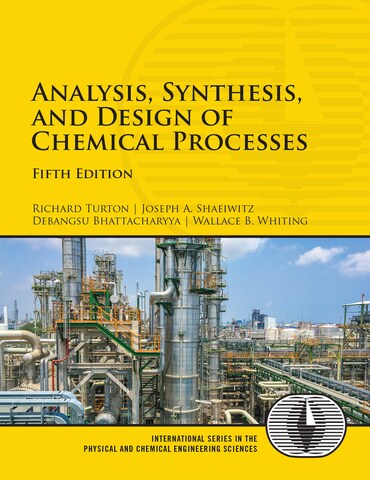
Analysis, Synthesis, and Design of Chemical Processes, 5th edition
- Richard Turton |
- Joseph A. Shaeiwitz |
- Debangsu Bhattacharyya |
- Wallace B. Whiting |
Title overview
More than ever, effective design is the focal point of sound chemical engineering. Analysis, Synthesis, and Design of Chemical Processes, Fifth Edition, presents design as a creative process that integrates the big-picture and small details, and knows which to stress when and why. Realistic from start to finish, it moves students beyond classroom exercises into open-ended, real-world problem solving. The authors introduce up-to-date, integrated techniques ranging from finance to operations, and new plant design to existing process optimization.
Coverage includes updated safety and ethics resources and economic factors indices, as well as an extensive section focused on process equipment design and performance, covering equipment design for common unit operations, such as fluid flow, heat transfer, separations, reactors, and more. For each equipment type, it presents design rationales and correlations; rating, sizing, and mechanical considerations; performance assessment techniques; illustrative examples, and full sample designs.
- Teaches design as the focal point of chemical engineering practice: a creative activity that continuously improves operations and enhances the quality of life
- Now covers the essentials of equipment design for common unit operations of fluid flow, heat transfer, separations, reactors, and more
- Contains examples illustrating principles and full designs for diverse types of equipment
- Teaches concepts and techniques for developing new facilities, modifying current processes, and optimizing or troubleshooting existing equipment
- Brings together wide knowledge for analyzing the big picture, recognizing crucial details, and knowing when to focus on each
- Also contains updates to Safety and Ethics websites and economic factors
This Fifth Edition includes major changes to Section 4, now retitled “Process Equipment Design and Performance.” It replaces underutilized content with crucial coverage of the basics of
equipment design for the common unit operations found in the processes described throughout the text and in Appendix B. These include fluid flow, heat transfer, separations, reactors, and some miscellaneous equipment. For each equipment type, it includes design rationale, rating and sizing methods, and material on evaluating performance of existing equipment. Students will learn which correlations to use, rationales for sizing, and key mechanical considerations. Each chapter contains multiple examples illustrating key principles, full designs for different equipment types, and end-of-chapter problems. These chapters’ hands-on approach will enable students to create their own designs and check these with more rigorous approaches available in custom programs and process simulators.
This edition will also include updates to websites associated with Safety and Ethics chapters, as well as updates for economic factors (CEPCI and other indexes).
Table of contents
-
Section I: Conceptualization and Analysis of Chemical Processes
-
1. Diagrams for Understanding Chemical Processes
-
2. The Structure and Synthesis of Process Flow Diagrams
-
3. Batch Processing
-
4. Chemical Product Design
-
5. Tracing Chemicals through the Process Flow Diagram
-
6. Understanding Process Conditions
-
Section II: Engineering Economic Analysis of Chemical Processes
-
8. Estimation of Manufacturing Costs
-
9. Engineering Economic Analysis
-
10. Profitability Analysis
-
Section III: Synthesis and Optimization of Chemical Processes
-
11. Utilizing Experience-Based Principles to Confirm the Suitability of a Process Design
-
12. Synthesis of the PFD from the Generic BFD
-
13. Synthesis of a Process Using a Simulator and Simulator Troubleshooting
-
14. Process Optimization
-
15. Pinch Technology
-
16. Advanced Topics Using Steady-State Simulators
-
17. Using Dynamic Simulators in Process Design
-
18. Regulation and Control of Chemical Processes with Applications Using Commercial Software
-
Section IV: Process Equipment Design and Performance
-
19. Fluid Mechanics
-
20. Heat Transfer
-
21. Separations
-
22. Reactors
-
23. Other Equipment
-
24. Process Troubleshooting and Debottlenecking
-
Section V: The Impact of Chemical Engineering Design on Society
-
25. Ethics and Professionalism
-
26. Health, Safety, and the Environment
-
27. Green Engineering
-
Section VI. Interpersonal and Communication Skills
-
28. Teamwork
-
Appendix A. Cost Equations and Curves for the CAPCOST Program
Author bios
Richard Turton, P.E., has taught the design and design-related courses at West Virginia University for the past 32 years. Prior to this, he spent five years in the design and construction industry. His main interests are design education and process systems modeling.
Joseph A. Shaeiwitz taught design and design-related classes at West Virginia University for more than 25 years. He now teaches design at Auburn University. His interests include design education and outcomes assessment.
Debangsu Bhattacharyya has more than ten years’ experience in a large petroleum refinery. While in the refinery, he worked in process operations, plant start-up, large-scale process simulation, and process control. His main research interests are in process modeling, dynamic simulation, state estimation, sensor placement, and advanced process control.
Wallace B. Whiting, P.E., is professor emeritus at University of Nevada, Reno. He has been involved in the practice and teaching of chemical process design for more than 24 years.